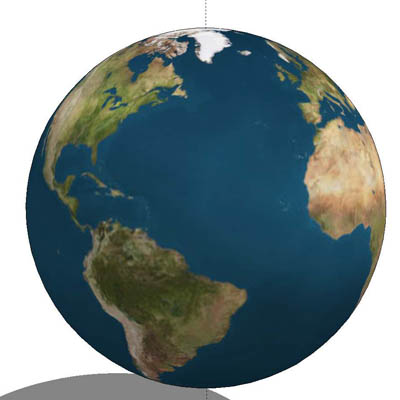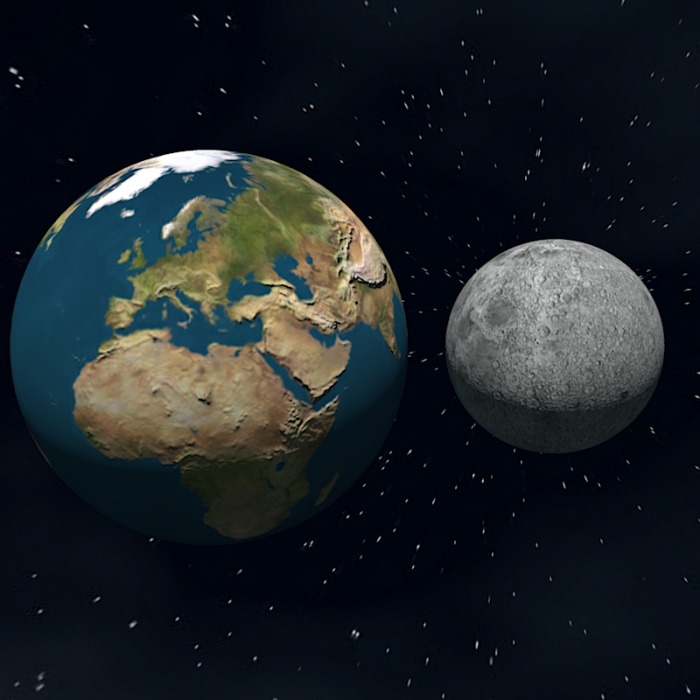[Plugin] UVTools v0.1
-
Well, it fails with every model I've exported so far, but here's the most recent one.

With some models, there seems to be the change of the actual texture when exporting.
The other spheres surrounding the model are the atmosphere and cloud layer.
Thanks again, Whaat!
-
@jon said:
Well, it fails with every model I've exported so far, but here's the most recent one.

With some models, there seems to be the change of the actual texture when exporting.
The other spheres surrounding the model are the atmosphere and cloud layer.
Thanks again, Whaat!
Thanks, Jon.
This seems to be an issue with non-triangular faces. If you can somehow triangulate the geometry prior to exporting, then the UVs should still be correct.
My 'Polyreducer' script triangulates all of the faces of a mesh. However, it will also reduce some polys. (The minimum is 10%). Once I triangulated your spheres, I reapplied the spherical mapping and then exported to Indigo. It worked perfect! I expect it to work with other rendering engines as well.
Another script that will triangulate faces is my 'SubD and Smooth' script (but it's not free)
Thanks for posting the scene!
-
Thank for the info, Whaat.

-
and here we go - with a perfect spherical mapping in Indigo!
triangulated faces. thanks whaat, that really did the trick

-
Thanks for the plugin.
 It works. You might encounter problem of reversed faces in SU and it will look kind of crazy. Reverse faces and it works. Tried quick render in Podium and it works no problem.
It works. You might encounter problem of reversed faces in SU and it will look kind of crazy. Reverse faces and it works. Tried quick render in Podium and it works no problem. -
Excellent work, Dale. The key to decent spherical mapping lies in a combination of triangular faces (no real surprise there) plus enough of them to do the job. Attached is the standard SU sphere which has been given 2 iterations of Subdivide and Smooth to produce much smaller triangles, then a spherical map of the Earth applied. The result is about as good as it gets.
My sincere compliments.I haven't tried it yet, but it may be possible to raise the resolution of the mesh in just the polar regions and achieve pretty much the same result but with far fewer faces.

-
Nice results Alan!
I wil give the plugin a spin this weekend. Another cool Whaat piece of work.
-
Dear Alan,
Could you give a little tut to show how you map the texture onto the sphere using the various tool? I cannot quite see how it all hangs together.
Thanks,
Bob -
It's fairly straightforward, Bob.
I imported the sphere from Shapes and exploded it.
I then applied Subdivide and Smooth with 2 iterations (it maps reasonably well with just 1, but 2 is better)
I then resized the sphere to exactly 10' diameter...it's a tad larger than that by default.
I imported the image and exploded it, then edited its height in the Material Editor to match the sphere's diameter.
I then applied the image, from the Material browser to the sphere.
I then right-clicked the sphere and chose UV Tools > Spherical from the context menu....and Bingo!
That's all there is to it. -
@alan fraser said:
I then resized the sphere to exactly 10' diameter...it's a tad larger than that by default.
I imported the image and exploded it, then edited its height in the Material Editor to match the sphere's diameter.Resizing the image before using the plugin is an unecessary step. The plugin will always map the image the full height of the sphere and wrap it exactly once around the sphere.
-
Thanks Dale. I should have figured that with no adjustment controls, it would be set to fit. I've only just taken a look now at the code.
-
Dear Alan,
Many thanks for the detailed explanation. As I wrote somewhere else, I tend not to texture my models, being content with the default shades, and so I haven't built up any skill in this area.
Thanks again, and thanks to Dale for another useful script. The model of the globe is really very impressive. I must have a go at Mars.
Kind regards,
Bob -
Bob,
You'll find some decent planet maps here.
http://planetpixelemporium.com/planets.html
The individual planets are linked at the bottom of the page.The maps are distorted because in order to fit a sphere the entire top and bottom edges need to come to a single point at either pole, so you'll appreciate that things get progressively stretched as you move away from the equator.
You don't need to start from scratch. You can merely open the Earth globe skp, go to the Material browser...In Model, select the Earth texture then in edit mode replace the earth.jpg with one of the planetary ones you download from the above site. It will map automatically.
-
Thanks for both the tut' and the link to the planet texture maps, Alan..!!

Much appreciated..!!
-
Dear Alan,
Many thanks for taking the time to post the link. I will have a go at that when I have a moment. I would also to create a background/sky dome simulation of Mars too. The reason for that is we have a couple of projects which involve instruments for Martian atmosphere monitoring, and it would be rather nice to see the lander in a Martian setting. Alternatively, I could get on with some real work.
Kind regards,
Bob -
i had a play with the plguin and found if i reduced the texture scale just a bit the mapping at the poles tended to clear.
Also exported to Maxwell with no issues!!!
Whaat again you do some absolutely amazing stuff mate!
-
Thank you, Whaat!

-
hi there.

Is it not possible to re write the plugin to see the mapping box,a way to scale the box or edit and maybe include a box mapping too. Similar to what max is doing.But from me to you...congrats..its super so far. -
i tried the ruby , but there is a problem when exporting to Kerkythea ..... it converts the shape to lots of faces whit lots of textures!!!!!!!!!!!!!! would be it reviewed to solve this problem?
yours majid -
Majid,
Whaat have already provided an answer to this...

@whaat said:
This seems to be an issue with non-triangular faces. If you can somehow triangulate the geometry prior to exporting, then the UVs should still be correct.
My 'Polyreducer' script triangulates all of the faces of a mesh. However, it will also reduce some polys. (The minimum is 10%). Once I triangulated your spheres, I reapplied the spherical mapping and then exported to Indigo. It worked perfect! I expect it to work with other rendering engines as well.
Another script that will triangulate faces is my 'SubD and Smooth' script (but it's not free)
Below is made using the SubD and Smooth script and exported using SU2KT...

Works like a charm...!!

Advertisement







